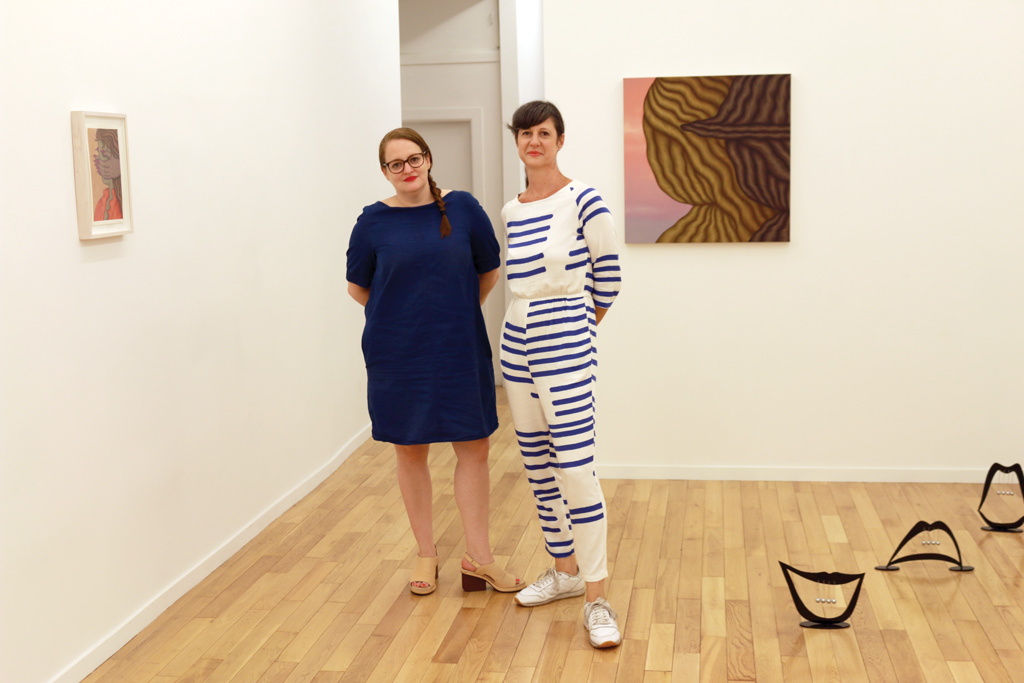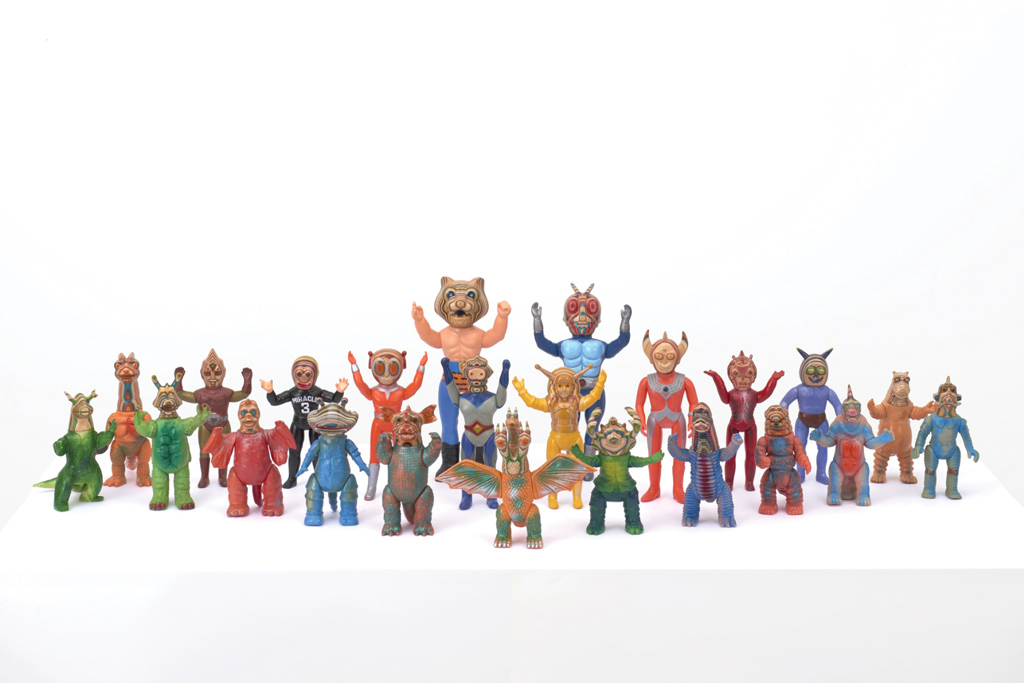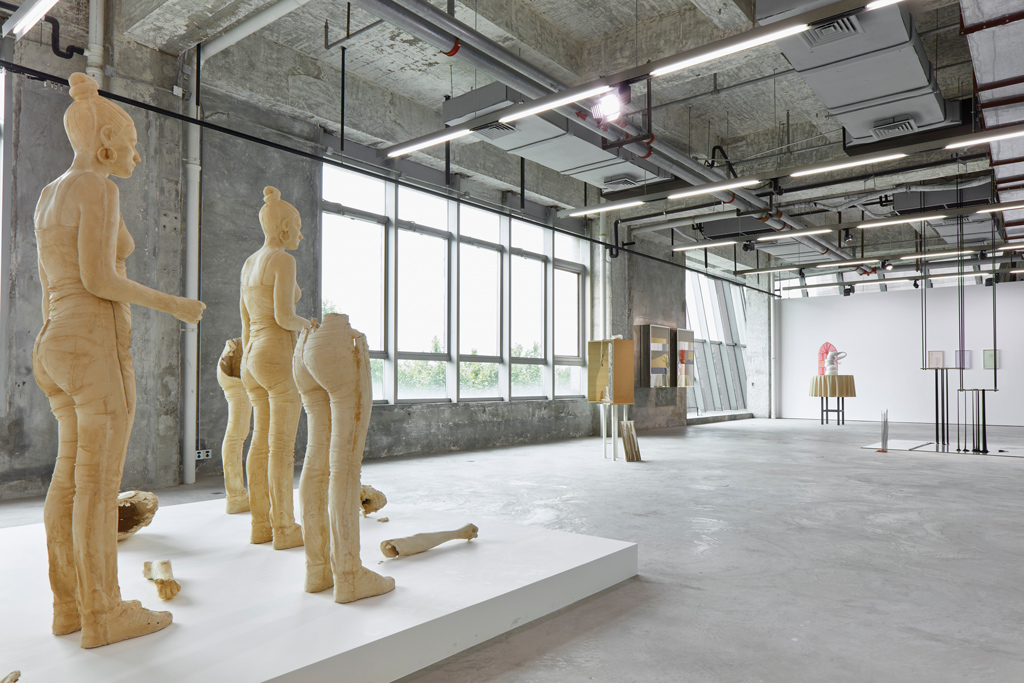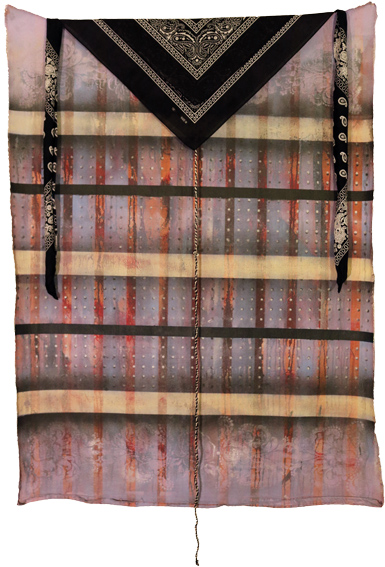[ad_1]

Nicole Russo and Simone Subal, organizers of Condo New York, in Russo’s Lower East Side gallery, Chapter NY, on July 27, 2018.
©KATHERINE MCMAHON
On a sweltering afternoon in late June, gallerygoers, undeterred by the weather, were popping in and out of the art spaces that dot Manhattan’s Lower East Side. It would not have been an unusual sight—galleries tend to coordinate their openings—except for the silver-sheened sheets of paper the people carried. Those sheets were maps directing them to exhibitions imported from cities around the world—Hong Kong, London, Dubai, Tokyo, Chicago, Glasgow, and Auckland, New Zealand, among them.
For a few weeks this past summer, New York played host to 26 galleries from out of town, representing major art hubs like Berlin, Los Angeles, and Paris, and other locales more far-flung. Experimenter gallery from Kolkata, India, brought a suite of minimalist drawings, paintings, and sculptures—all of them resembling architectural elements or building plans—by artists like Ayesha Sultana and Kanishka Raja. From Prishtina, Kosovo, LambdaLambdaLambda brought an installation by Hanne Lippard that involved a recording of the artist’s voice intoning phrases culled from advertisements. Nanzuka gallery of Tokyo showed a piece by Haroshi, an installation crafted from 23 action figures, some of which held up their tiny arms as if looking for a hug.
Typically, when this many galleries exhibit in one city, they do so in booths at an art fair. But these galleries were selling their wares in the spaces of 21 of their New York–based colleagues, as part of the second edition of an annual four-week program called Condo New York. Among the host galleries were older, more established ones, like Petzel, Metro Pictures, and Alexander and Bonin, and younger ones, like Bridget Donahue, JTT, and Bodega.
On opening day (Condo typically has two preview days, as well as a vernissage), Simone Subal, who organized the New York program with Chapter NY gallery director Nicole Russo, was busy alternately fielding questions from this reporter and from collectors, the latter inquiring about the works on view, including paintings by Daniel Sinsel, which came courtesy of London’s Sadie Coles HQ gallery, and video installations by Anna K.E., whom Subal represents.
“We knew we had to do something, be active and proactive, and not only participate in the system, but also create and engage in something new,” Subal said of Condo, adding that, in order for young galleries to survive today, “you just need to think about certain models that would be better.”

Vintage action figures with carved skateboard elements by Haroshi were on view during Condo New York, as part of a collaboration between Petzel and Nanzuka.
COURTESY THE ARTIST AND NANZUKA
For many smaller single-venue galleries like Subal’s, the art system is no longer working. Midsize galleries, amid a spate of closings, cite rising rents and declining foot traffic, and many complain of a general feeling of instability and pressure to participate in more fairs. In a New York Times op-ed earlier this year, the sociologist Olav Velthuis wrote, “Because of the recent changes in how art is viewed and bought, smaller and midsize galleries are in a vicious bind: How can they possibly participate in the fairs? At the same time, how can they not?”
Arts Economics founder Clare McAndrew’s 2018 report on the global art market, released through Art Basel and UBS this past March, painted a bleak picture for young galleries today. The report noted that, in 2017, there were more gallery closures than openings. More sales were made at art fairs in 2017 than in 2016, but they came at a cost, literally—galleries paid more to participate in fairs than in the year prior. “One of the biggest concerns dealers expressed in 2017, regardless of their turnover levels,” McAndrew wrote, “was the changing infrastructure of the market, with the greatest performance year-to-year and longevity over time found at the top end of the market.” Those concerns were exacerbated by the closing of “more than 20 notable galleries in some of the mature markets.”
It’s a problem that nearly everyone working in the contemporary art market recognizes, including the megadealers at the opposite end of the spectrum from galleries like Russo’s and Subal’s. This past April, at the New York Times Art Leaders Network conference in Berlin, David Zwirner, with gallery locations on three continents, said, “I do feel something is wrong with the current system,” noting that “the younger galleries are having a harder time to compete.” His solution was a “tax” on large, established galleries at fairs that would, in turn, support emerging galleries’ participation. One audience member, Pace Gallery president Marc Glimcher, shouted, “Let’s do it.”
Art fairs themselves are feeling the pressure to do something to even the playing field. In May, for instance, Frieze New York lowered booth costs for its younger sections. In an interview with Artnet News in June, as Art Basel in Switzerland was opening its annual run, Art Basel director Marc Spiegler said the fair is having internal conversations about “fair mechanisms that could counterbalance the consolidation within the art market.” He added, however, that “an even bigger and more important discussion is about what we can do to help galleries be more successful on an ongoing basis.” Those efforts, he said, include promotional support from Art Basel’s social media and media-relations divisions and a special VIP collector program aimed at mid-level galleries. (In September, Art Basel announced that it would follow Frieze’s lead and lower booth prices, such that two thirds of the exhibitors at the fair’s Swiss edition in June 2019 will pay less than they had in years prior.) In August, the New Art Dealers Alliance announced it would cancel the New York edition of its fair next March to focus on helping the city’s galleries with programming that coincides with Armory Show Art Week.
But even as these big players wring their hands, collaborative programs like Condo are combating a hostile environment with support networks and a sense of community. Galleries are figuring out ways they can help change the system themselves. But how far can that take them?

Julie Curtiss, Blinders, 2017, gouache on paper.
COURTESY THE ARTIST, CHAPTER NY, AND ADAMS AND OLLMAN, PORTLAND, OREGON
When Vanessa Carlos, coproprietor of London’s Carlos Ishikawa Gallery, started Condo in London in 2016, she considered: What would happen if we did things differently? What could that look like?
The stirrings of a collaborative spirit had been in the air since 2009, when galleries were looking for ways to weather the recession.
“After the 2008 financial crisis, galleries that were emerging, like mine, were looking toward new practices,” said Elizabeth Dee, owner of New York’s Elizabeth Dee Gallery. “That was a time of economic uncertainty, and out of it grew a lot of new models.” In 2010, Dee, in collaboration with adviser Darren Flook and others, launched the Independent art fair in New York (she now also runs an edition in Brussels). Dealers were invited to participate, and those dealers could then invite their colleagues.
By 2016 the art market had been through another boom that started with a cycle of rampant speculation on young talent; a culture centered around blue-chip galleries selling name-brand artists had also taken hold. Between 2000 and 2017, the number of fairs around the world quintupled, and younger and mid-tier galleries started to struggle. In cities like New York, galleries were caught in a complex balancing act. Rapid gentrification was causing rents to rise as gallerists were also showing at a multitude of art fairs, where it seemed that collectors were most willing to make big purchases. (This past February, José Freire, proprietor of New York’s Team Gallery, told Artnet News that he was quitting fairs altogether.) This combined economic pressure forced gallerists to start looking to each other for solutions.
In 2012 dealer Jeanine Hofland started A Petite Fair, which convened a group of galleries in her now defunct Amsterdam gallery; it was, as its name suggests, a small event. During Frieze week in New York in May 2016, the gallery Off Vendome hosted a five-gallery mini-fair. (Two of the five participants, along with Off Vendome itself, have since closed.) “It’s really frustrating, as a young gallery, that you feel like you’re giving up so much by asking people to validate what you’re doing,” Matt Moravec, Off Vendome’s founder, told me at the time. “Actually, your peer group should be the one that validates you.”
In September of that year, ARTnews published a report about the recent closures of “middle-class galleries,” or spaces that were neither really small nor really big. Most dealers in the report described feeling as though their midsize spaces weren’t long for this world. “The conglomerate model—there’s no doubt it’s going to annihilate a lot of mom and pops,” said New York gallerist James Fuentes.
A month later, in October 2016, Carlos launched Condo during Frieze week in London. “I feel like everyone’s struggling,” she told me recently. “Everyone’s complaining about the same things”—too many mediocre fairs, too few visitors actually going to galleries, and too little sense of community among gallerists.
Carlos wanted to create a program that was “generous to everyone,” she said, primarily to dealers, who “somehow end up at the bottom of the pile, even though we’re the ones whom you could argue are the most passionate, the most committed from the beginning. . . . I really think of it as a project for gallerists by gallerists.”
Her idea was that Condo host dealers would work in conjunction with their visiting colleagues to create and install exhibitions that intermingle artists from both rosters or take place in discrete gallery spaces adjacent to current exhibitions. This emphasis on collaboration extends to how editions of Condo are assembled. The local organizers identify host galleries, who are then asked to select their top five galleries from a pool of out-of-towners. The organizers use that information to pair them accordingly. As Subal put it, “we’re officially matchmaking.”
Gallerists and the media almost instantly saw Condo’s first London edition as the start of something influential and important. “Condo seems to have been successful: the initiative meant lots of good non-London art to kick off the 2016 art year, which in itself is laudable,” a report in Flash Art noted. “There’s certainly an interest in circumventing the current art-fair system without losing its beneficial internationalism, and the format proposed here might be the most viable alternative thus far—a format that could blossom in cities all over the world.”

Installation view of “The Soul of the Soulless” at Edouard Malingue Gallery, 2018, part of Condo Shanghai.
COURTESY EDOUARD MALINGUE GALLERY
Blossom it did. Condo New York had its first edition in June 2017, followed by one in Mexico City this past April. There was a smaller-scale pop-up version in São Paulo that same month, and in July, the inaugural iteration of Condo Shanghai launched. Lorraine Malingue, the director of Edouard Malingue Gallery, of Hong Kong and Shanghai, and the organizer of Condo Shanghai, said it has been helpful in creating a global network of gallerists. “The way galleries currently exist, it really requires a lot of collaboration,” she said. Through Condo, “I think they’re better able to connect with foreign galleries that they maybe didn’t know before.”
Over coffee in her gallery in early June, Russo told me Condo New York has been a no-brainer for her peers in the city. “We didn’t actually have to sell it that hard—or hard at all,” she said. “It’s surprising how few emails we got where [gallerists] were, like, ‘No, I would never do this.’ Very few, almost none.” Part of it was the camaraderie. “I run my gallery pretty much alone,” Russo added. “I have one person who helps me. If I didn’t have all these [other gallerists] in my life, I wouldn’t be able to do it. For me, it’s as simple as that.”
At a time when smaller galleries are struggling with the cost of doing fairs, Condo represents an attractive financial model. Unlike a fair, where booth rentals can run into the thousands, Condo’s fee tops out at around $850, which covers a participant’s share of an opening night party and of producing a Condo brochure. (As with fairs, the galleries pay any installation costs associated with their presentation.) Shipping charges depend on what a gallery chooses to bring, but expenses for things like on-site fabrication, handling, and installation can be defrayed with help from the host gallery. Add in the price of a round-trip flight (around $1,000) and a three-day stay in an AirBnB ($250), and the total cost of Condo London can be as low as $2,950. This is already dramatically cheaper than a fair like Frieze London, where a booth in the “Focus” sector for solo presentations by emerging spaces runs around $9,500—before any other additional expenses.
Aside from giving up some exhibition space, host galleries pay nothing. “That’s our perk,” Russo said with a hearty laugh.
“The low cost—it’s so convincing, you know?” said Subal of her experience participating in the third edition of Condo London in January. The gallerists at the Approach, who hosted her, “were so beautifully generous and introduced me to a bunch of collectors. They fostered a real sense of community. I was only there for the opening weekend, but I met tons of new people, and I’m still in touch with them.”
This alleviates some of the sales pressure that galleries feel at art fairs: If you don’t happen to sell anything, your artists have still had exposure in a new city, and you aren’t out a sum that could sink your business. “I wouldn’t say that commercial success was any of the participants’ aim,” said Ana Castella, the codirector of joségarcia.mx gallery and the founder of Condo Mexico City.
Lately, some dealers have imitated Condo’s model and made the price of participation even lower. For a small initiative earlier this year, Los Angeles gallerists Paul Soto, Hannah Hoffman, and Kristina Kite worked together to host nine visiting spaces from around the world. According to Soto, the cost to participate was $50, which went mainly toward photographing the visitors’ presentations. And for Friend of a Friend—a gallery share program held for the first time earlier this year in Warsaw (a tiny pop-up version was also held at ChertLüdde gallery in Berlin this past summer)—a partnership with the Adam Mickiewicz Institute, the local government, and Frieze magazine helped ensure that there was no fee at all. “We came from the assumption that it should be similar to an invitation to dinner,” said Zuzanna Hadryś and Michał Lasota, the directors of Warsaw’s Galeria Stereo and the cofounders of FOAF.
But Condo’s most significant contribution to the gallery world may be simply to encourage collaboration. In September 2017, Okey Dokey—founded by dealers Laura Henseler, Jan Kaps, and Max Mayer—convened 20 international galleries at 16 spaces in Düsseldorf and Cologne. Like most other gallery shares, the emphasis was on community: the promotional image for the first edition was a mustard-colored, brain-like form that had the visiting galleries’ names sprouting from it and connected via curlicuing lines, as if to suggest a network being formed. (The gallery share’s second edition second edition is in its final few days.) Henseler, who is director of Cologne’s Ginerva Gambino gallery, told me that, to her, Kaps, and Mayer, “it feels right, even natural, today to want to collaborate on projects with your colleagues.”

Aaron Estrada, La Negra Tiene Tumbao, 2018, part of a collaboration between Mexico City’s Anonymous Gallery and Los Angeles’ Mistake Room for Condo Mexico City.
COURTESY THE ARTIST, ANONYMOUS, MEXICO CITY, AND THE MISTAKE ROOM, LOS ANGELES
If there are complaints about gallery share programs, it’s that they don’t last long enough for dealers to gain a foothold in a foreign city. In an interview with ARTnews earlier this year, Jenny Borland and Matthew Sova, the dealers behind the Los Angeles gallery Jenny’s, said that they were decamping for the former home of Chewday’s gallery in London for the summer “to engage beyond the art fair or gallery share models which are too short, and frankly not beneficial for a gallery at our level to participate in, while operating from as great a distance as Los Angeles.” (Commercial Street gallery, of Provincetown, Massachusetts, took up residence at Jenny’s Los Angeles space in the interim.)
To remedy this, a few galleries have collaborated on starting up semipermanent exhibition spaces outside their home bases. One example is Ruberta, a venue in Los Angeles that’s shared by five Latin American galleries—Galería Agustina Ferreyera (of Mexico City), BWSMX (Mexico City), Carne (Bogotá), Lodos (Mexico City), and Proyectos Ultravioleta (Guatemala City). Begun at the invitation of Los Angeles gallery the Pit and launched last year to coincide with Pacific Standard Time: LA/LA, the galleries use Ruberta on a rotating basis.
“Most of us are used to paying . . . to participate in fairs and have that kind of visibility internationally, and this was a different approach,” said Brett W. Schultz, the director of BWSMX. “It was much more reasonable, economically.”
Schultz noted that Ruberta functioned similarly to gallery shares—dealers spend the weekend in L.A. for an opening, meet with collectors and curators, and then head back to home base to manage their galleries. “I don’t think these models have arrived at any panacea yet,” Schultz added. “The logistics . . . sound good in theory, but the reality . . . is that, in terms of door-opening hours or accessibility to the general public, it’s pretty much the same as an art fair, except it’s spread out over a couple weeks.”
Schultz is realistic about the potential. “I don’t want to sound down on [programs like Condo] because I do think it’s important to have these initiatives,” he said, “but I also don’t want to overly encourage this rosy perspective that gallery share initiatives are going to change the world.”
Meanwhile, Carlos stresses that Condo is not meant as a replacement for art fairs. “Fairs that deliver”—the ones she said were equivalent to Art Basel—“are really important, but there’s not many of them that do,” she said. “I see Condo as a supplement to fairs.” Joségarcia.mx dropped out of Art Basel this year, but Castella, the Condo Mexico City organizer, told me that there was “no relationship” at all between her decision to launch a new Condo and the gallery’s choice not to show at the fair.
Asked how Condo will evolve in the future, Vanessa Carlos said the physical gallery share aspect will remain the same, but that she has begun to wade into the digital sphere. Working with collector Thomas Veith, she is developing an app called Condo x Tatlin that will link up collectors with Condo participants. “It would introduce gallerists to art, and collectors to each other and [to] people they might not otherwise have come across,” she said. The app will be free, and basically acts as “a digital version of Condo” for gallerists and collectors. “I don’t know if it’ll work,” she said, “but I’d rather try than just complain about it.”
A version of this story originally appeared in the Fall 2018 issue of ARTnews on page 106 under the title “Let’s Hang.”
[ad_2]
Source link

